Thank you Melissa for taking the time to speak
with us. Can you tell us about the image's context
and the assignment that led up to it?
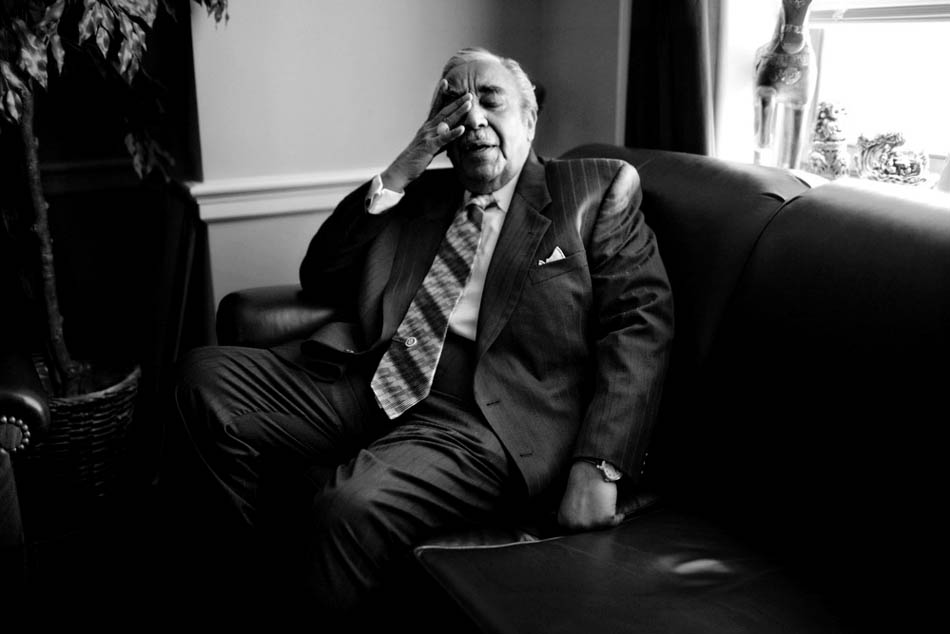
MELISSA:
In July of 2009, I got my first assignment from Time Magazine.
They wanted me to photograph the legendary, scandal-plagued
Congressman Charles Rangel. The idea was to shoot a combination
of portraits and reportage. Getting to follow up a portrait session
with a day-in-the-life shoot is an absolute treat for me, and I really
like being able to do it in that order. The idea being that the subject
becomes inured to you by the end of the portrait session, freeing
them up for genuine moments the rest of the day. Of course, Charlie
Rangel is a public figure, and as such he had no problem forgetting
I was there once it came time for me to become a fly on the wall.
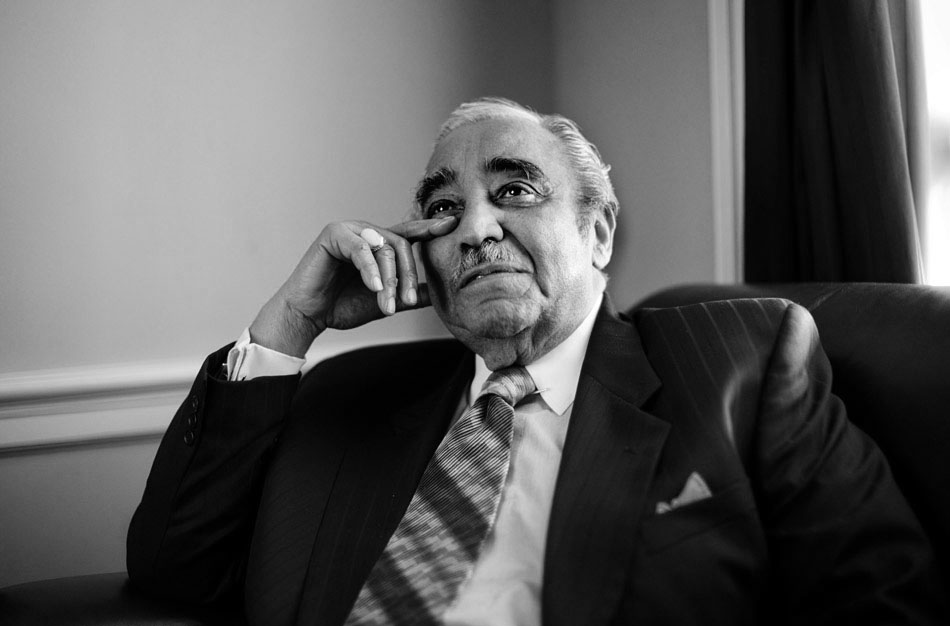
MELISSA: Another moment, shot in natural light.
I arrived early. Very early. The timestamp on my first pictures says
8:24 a.m. and my first shot of the congressman is at 11:32 a.m. Yes,
he was running a little bit behind, but that gave me the luxury of
shooting the hell out of his office and getting to know the space
intimately before he even showed up. I, along with my assistant for
the day, fellow photographer Brendan Hoffman, spent 3 hours scouting
and doing test shots. I had seven setups prepared before the congressman
showed up and I hit all seven in the generous 35 minutes he gave me.
I like to give my editors options and since this was a new and very
exciting client, I wanted to cover all my bases and nail the portraits.
I shot verticals and horizontals, strobed light and ambient light,
posed and candid. I also try to let the space and mood dictate
the feel of images as well. I try not to enter with too many preconceived
notions and I try to work with what I’m given and make it sing.
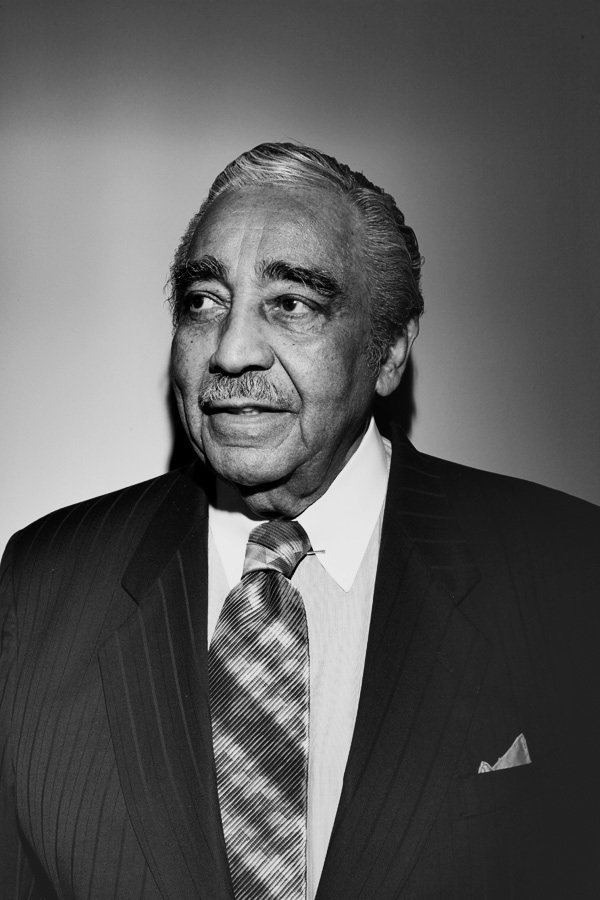
MELISSA: This is the image that my assigning editor wanted to run.
TID:
Ok, onto the image - can you describe what was going on in
your mind as the image took shape? Please also tell us what you
were thinking when you made the image.
MELISSA:
We were 30 minutes into the shoot when I asked the congressman
to relocate yet again. He stood and I pointed to his couch by the
window. He walked across the room, sat down there and then he
took a moment. He broke character. This is not to say that he was
acting before that point, but public figures tend to have public
personas. We all do, to a certain extent. Most folks want to show
their best face to the camera, especially when one is being photographed
for a national magazine and is under the microscope for one’s actions
as Rangel was. I actually found him quite genuine and he gave up a
lot of “moments” that some other individuals with more tightly controlled
personas may not have. That didn’t change the fact that for the
majority of the shoot, he, like most of the people I’ve ever photographed
for a portrait, played to the camera.
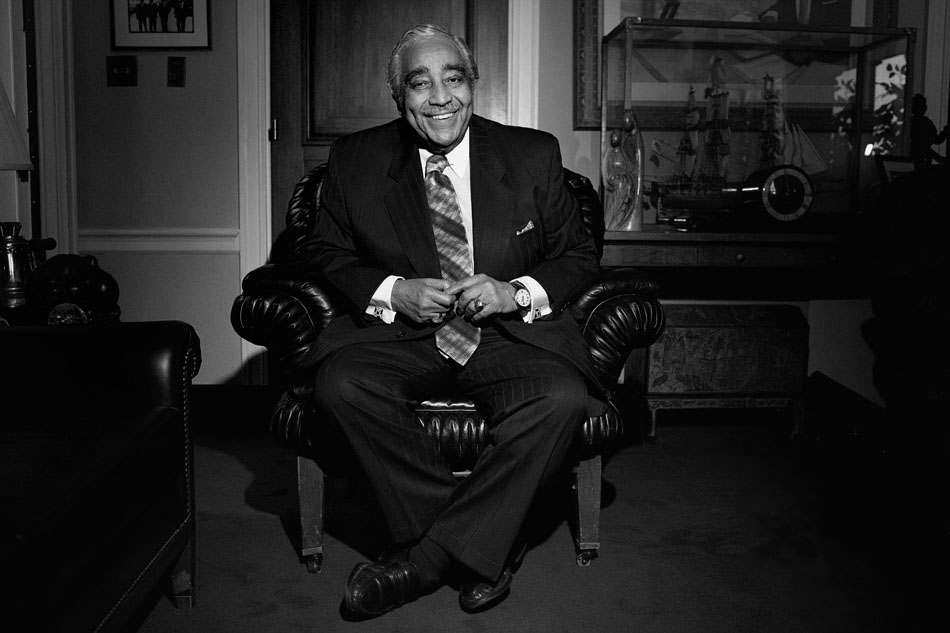
MELISSA: I'm a fan of the body language in this shot. His legs say "relaxed" but I think his hands say "tense."
If I had been looking at the back of my camera or doing anything
else, I would have missed the moment of weariness - it could have
been the weariness of a long life, a tough career, a difficult road
ahead or a poor night’s sleep. I don’t know which it was. It didn’t
matter. He showed it, I photographed it and that was it.
A note about this: I definitely chimp when I move to a new setup -
I like to make sure the light and settings are right, but I was too
engaged by this shoot to be bothered to look.
I remember gasping a little to myself when I saw what I had. I
didn’t care about the rest of the pictures that day- I knew I had
the shoot in the bag from a client-pleasing perspective. That
one frame was “it” for me. It was my genuine story-telling image.
This is a picture of a tired man. Why is he tired? Let me count
the ways.
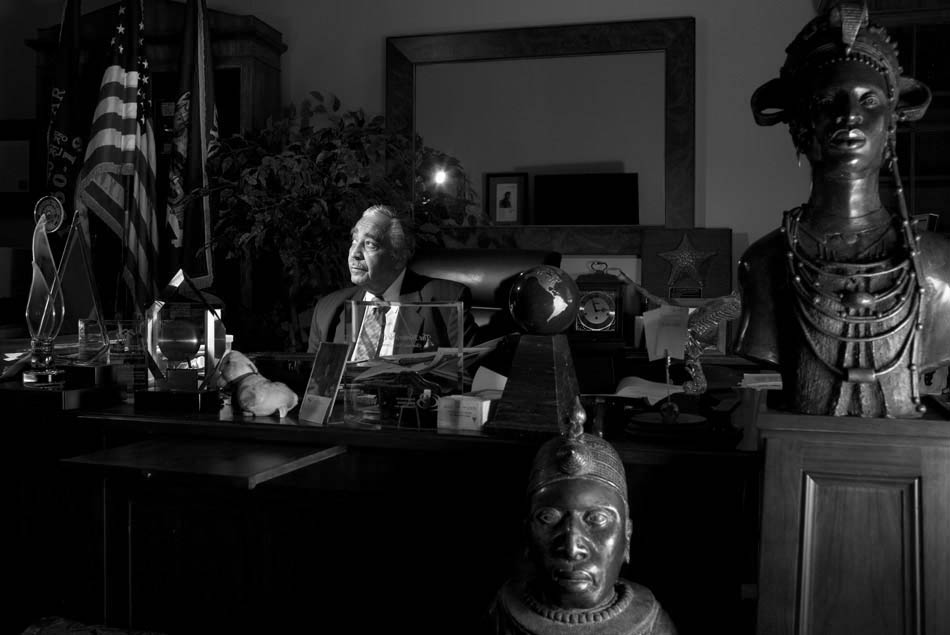
MELISSA: This is the image that actually ran with the article. I got some flack over the light reflected in the mirror, as though it was a mistake. I deliberately shot it that way after noticing in the first few frames that it was showing up. I even adjusted my aperture to give it more of a starburst effect. I admit it's a little cheesy, but I think it looks like his conscience.
TID:
What were some problems or challenges you encountered
during the coverage of this event, and how did you handle them?
MELISSA:
The congressman’s lateness proved to be beneficial, he gave me
a great deal of time to make his portrait and he did not limit my
access the rest of the day. It was actually a dream shoot by
Capitol Hill standards. Later in the day as I was shadowing him,
he met with then governor David Patterson behind closed doors.
I snuck into the room to get a few shots of them speaking
together alone and the congressman didn’t say anything. After
a minute or two, the governor, who is blind, must have heard me.
He cocked his head and gave the congressman a quizzical look as
if to say “am I really hearing a camera shutter right now?” Rangel
didn’t miss a beat and said to the governor, “That’s Melissa from
Time. Don’t worry, she’s deaf.”
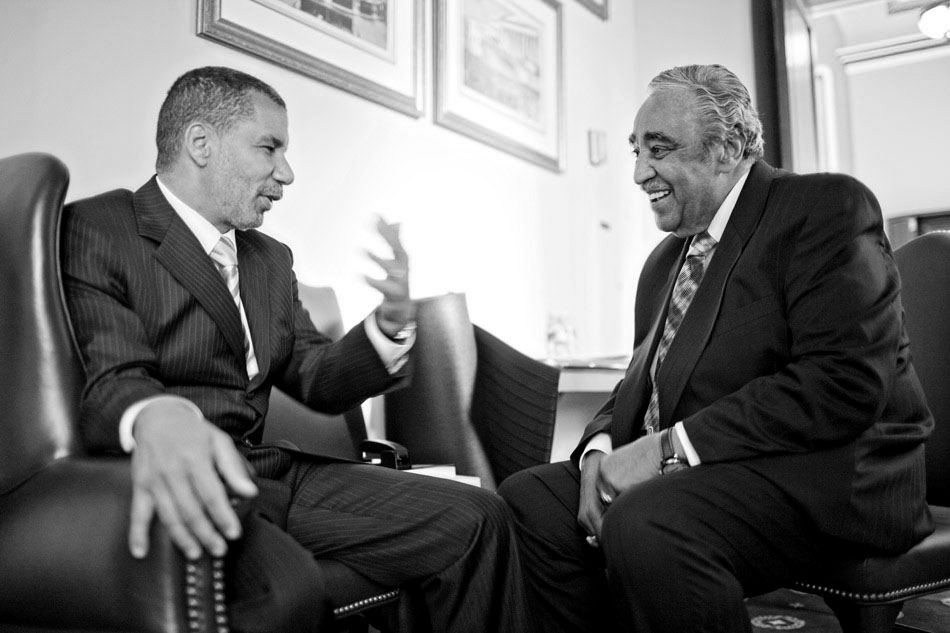
MELISSA: The private meeting between Rangel and Patterson churned out a couple of real nice moments.
It’s a funny story, but it illustrates the level of trust we operate on
in DC. Yes, I’m a journalist and no, nothing was technically off the
record, but for me to be in that room shooting that meeting, I
closed my ears. I can tell you that they were talking some serious
inside baseball about players I didn’t even know and the language
wasn’t entirely political, but that’s the extent of my reveal. As a
visual journalist, to gain trust and access to powerful figures, it helps
to observe a basic protocol of “deafness.” While this may sound
strange to those of you with journalism school degrees- I assure
you that I’m only ever half deaf, but my eyes are always open. I
observe and I try to use my other senses to inform what I see, but
it’s not my job to report on the details of secret meetings. My job
is to sometimes shoot them. It’s a privilege to be given that degree
of trust.
When I photographed Secretary of State Clinton at the State Department,
I was sitting in on meetings that I didn’t have any sort of clearance for.
We’re talking top-level discussions on foreign relations and intelligence.
Was any of it earth-shattering, revealing material? No, not really. If I
ever hear anything that could change the course of history, I’ll be sure
to tweet about it. Until then, I’m half deaf.
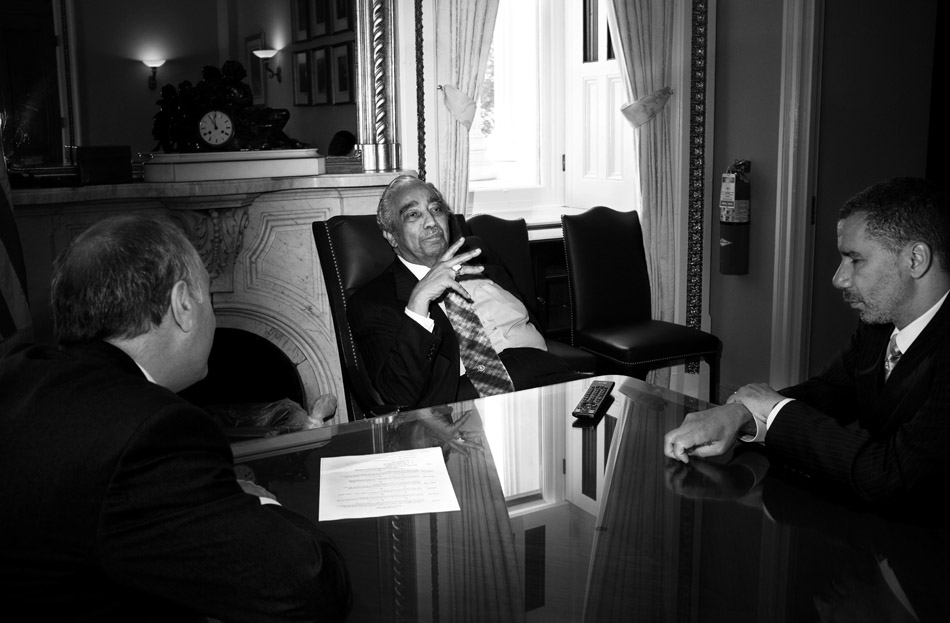
MELISSA: Rangel's body language here says "I rule this room." Love it.
TID:
Could you talk about the process of photographing in DC, or with
politicians in general? Anything from logistics of getting gear through
security to dealing with handlers, setting up situations and having very
small amount of time, etc. Something that could give insight to students
or someone who has never worked in those situations.
MELISSA:
Working as a photographer in DC and on Capitol Hill in particular is
a little different from working most other places. In order to easily
get in and out of the Capitol complex, I have to have press credentials
issued by the Senate Press Photographers Gallery. I have to put all
my gear on a conveyer belt and walk through security when I first
enter a congressional office building or the Capitol itself, but once
I’m in, I can navigate through a warren of underground tunnels to
get to any other building in the complex. It’s great for rainy/snowy
days.
Congressman Rangel’s office (which is easily the best-decorated
office in DC that I’ve been to) is in the Rayburn House Office
Building. I get lost in the House and Senate office buildings all
the time. I also get lost in the basement of the Capitol. It’s
embarrassing to admit, but it’s true. Beyond the fact that I’m
directionally challenged and that you have to put all your gear
through security, shooting on the hill is pretty easy.
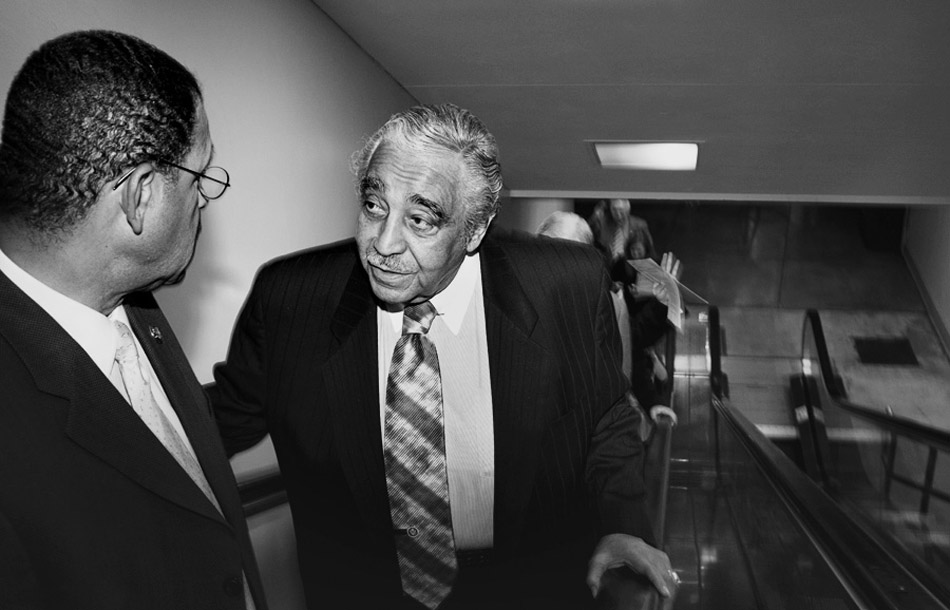
MELISSA: Moving through the Capitol complex, it's always important to stay a few steps ahead. You get real good at walking backwards. This can get dangerous in crowded halls or on escalators.
Photographers must observe some basic protocol (no taking
pictures in the cafeterias and no shooting into the House or
Senate galleries) and while there’s no formal dress code, I try
to dress appropriately. No jeans. I live in jeans so this one
is hard for me, but I feel the need to respect the history and
gravity of the institution. Jeans are generally not appreciated
in DC. I remember my first time at the White House- I wore a
suit and got to go into the Oval Office, but some videographers
in jeans were not permitted access. It might seem uptight, but
that’s how we roll around these parts. As uptight as things can
be in DC, the access to politicians is remarkably good. I’ve
dealt with a few celebrity handlers in my time and they can make
any shoot an exercise in rage control. The handlers here (who
I’ve worked with) are shockingly laid back. It’s a little surprising,
but then again the politicians are not only public figures but
also public officials and they must remain accessible to the
public and the press to a greater degree than your
run-of-the-mill celeb.
TID:
What are your ideas/philosophy about capturing "moments" in
set-up or portrait situations?
MELISSA:
I got my start in newspapers, where “portrait” was kind of a
dirty word. If you had to make a portrait of someone, it meant
you couldn’t manage to get them in action, and there were
no real acceptable excuses. In newspapers, I got the strong
impression early on that portraits were the last resort of the
lazy/incompetent photographer. There are exceptions, like a
pre-conceived portrait series, but I tried to never shoot a
portrait for an assignment when an action shot was within
the remote realm of possibility.

MELISSA: He had to take some calls during the portrait session, so I kept shooting. This is what I mean when I talk about the spontaneous moment within the setup.
Nowadays, I shoot primarily for magazines and at least 80% of
my assignment work is portraiture. It was extremely counterintuitive
at first - I didn’t feel comfortable directing. It felt downright
unethical to tell a subject where to stand or how to look.
Slowly, I began to realize that the very nature of portraits
allows me to control elements that had previously been out
of my hands as a news photographer. I was no longer limited
to the confines of attempting to capture what was unfolding
before me. I could directly craft the image to tell the story.
I became increasingly hands-on, but never felt truly comfortable
with the images I took that were purely direction. I felt they
said more about me than my subject.
Over time, I learned that there is an exquisite middle ground -
the spontaneous moment within the setup. That is what I aim
for in every single one of my portrait sessions. I approach each
subject differently to achieve this. Sometimes I’ll bark orders.
Other times, I’ll have a friendly conversation and find common
ground to create a connection. Sometimes, I don’t say a word,
I just shoot and let the silence get awkward and uncomfortable
until the subject can’t stand it. It really is different with
everyone and I try to feel out my approach within the first
minute of meeting the subject. With Rangel, I put him through
the paces and just kept shooting. No one can smile for 5
minutes straight - the muscles start to give out after a while.
TID:
Was there anything that you learned or put to use in
later assignments that come about from this experience?
MELISSA:
When preparing for a big shoot like this, photographers have a
lot on their minds. They have to figure out gear and logistics
and be prepared for anything, and when you’re busy worrying
about that it can be easy to forget one of the easier things you
can do to ensure a good shoot. Research your subjects when
possible! There are a number of advantages to this. It can help
you make more informed images, but it also tends to put you on
a more level playing field when dealing with powerful people.
Knowing way more about them than they know about you shifts
the power dynamic instantly. You can use what you know about
them to either put them at ease or put them on edge, depending
on what the situation calls for.
I’d read up on the congressman before my shoot, but my
three hours in Rangel’s office before the shoot
allowed me to study him further. By the time he showed
up, I knew what I wanted to incorporate into the
images and why. To make him more comfortable, we could
have discussed African art, Harlem and Korean War history.
To put him on edge, I could have brought up any aspect of his
scandal with which I was intimately familiar thanks to some
reading in the days before the shoot.
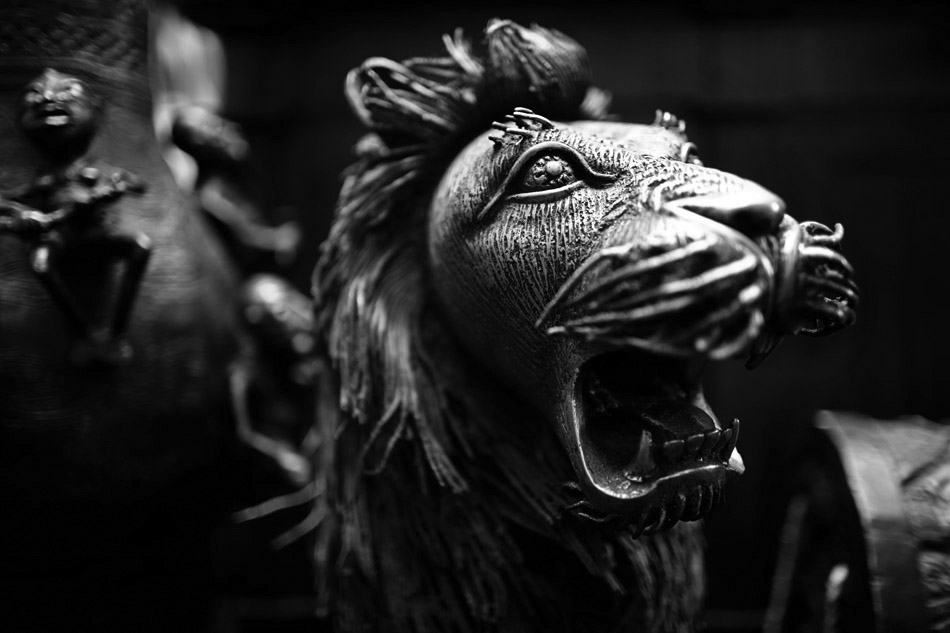
MELISSA: While waiting in the congressman's office, I made sure to shoot some of his decor which consisted of medals, awards and a lot of art - most of it African. I thought this lion was a particularly nice detail because Rangel is known as the Lion of Harlem. He is also a war hero who fought in the Korean conflict. This made him electable early on, but in the context of his modern troubles I wanted to show that there is a depth and complexity to the man beyond your typical scandalous politician.
My extra long setup on this shoot clued me in to the notion that
it’s a lovely thing to have plenty of lead-time. I generally like to
jump into situations, guns blazing, but it’s nice when you can
provide yourself the luxury of a slower, more thoughtful shoot.
Additionally, there were many, many hours of post work on this
shoot. I toned up almost 100 selects to magazine print standards
because I wanted to make a good impression. When I worked in
newspapers, if I turned in more than ten images from an assignment,
I’d be chided. When I worked in wires, any more than twenty
pictures and I’d get in trouble. When I made the switch to
magazines, it was very strange to hear, “What else do you have
from this?” I thought I had gotten pretty good at picking a handful
of my very best selects and now I was being asked to submit entire
takes. My typical submission of selects for my magazine clients
ranges from 40-60 images. I’ve since learned that I can do a quick-
tone on the low-resolution files (which still takes me an hour or
two in Lightroom) and then I do the extra work on the requested
hi-resolution images when that order comes in. Getting my workflow
down for magazines has really helped me to be more efficient with
my time. I wasn’t kidding when I said it took me many hours of
post on the Rangel shoot. I watched six or seven movies while I
did it.

I’ve learned most of these kinds of lessons through trial and error.
There really isn’t room for error as a freelancer because if you
screw up with a client, you don’t get hired again. My errors have
thankfully been mostly of the variety I could fix before the client
was affected. I subscribe to PDN and a lot of photography blogs to
make sure I’m up on the latest tools that can help me get my job
done faster/better/easier. I’m always self-educating. When I find
myself admiring a photographer’s output, I don’t sit back and
wonder how they did it. I buy ‘em a meal and a drink and start
asking questions. The Image Deconstructed blog is a valuable
resource that I wish had been around when I was first getting
started. That’s not to say I don’t learn anything from reading it
now, but I envy the kids in photo school today who have instant
access to incredible amounts of focused information on every
aspect of photography imaginable.
++++
Melissa Golden is an editorial photographer based in the DC metro area, but she isn’t really from anywhere in particular. Her nomadic childhood, courtesy of the United States military, has led to a life marked by continuous change, renewal and wanderlust. Her work is influenced by all the places she’s called home at some point- the brazen oddity and beauty of Southern California, the tradition of the Deep South, the storm light of rural Florida, the heady intrigue of the Middle East and the stiff formality of the District of Columbia. She may not know where she’s going next, but her pictures help her to keep track of where she’s been.
http://www.melissagolden.com/
http://www.goldenhourblog.com/
+++++
Next week we'll feature this wonderful image by Chris Tyree:
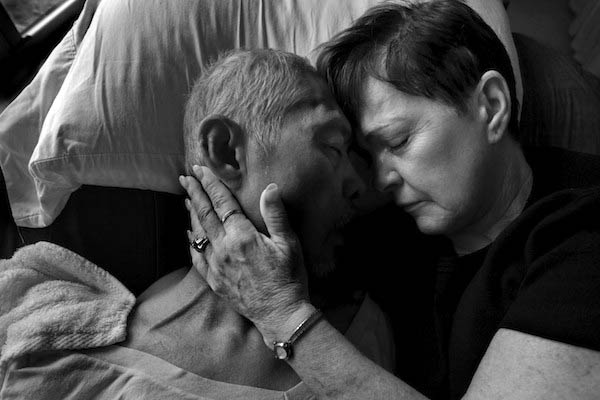
As always, if you have a suggestion of someone, or an image you
want to know more about, contact Ross Taylor or Logan Mock-Bunting:
ross_taylor@hotmail.com
logan@scott-free.com
For FAQ about the blog see here:
http://www.imagedeconstructed.com/
Wonderful Break down Melissa! It pays to be prepared. - P. Wartena
ReplyDeletea beautiful photo essay. i am happy to have seen it. all the best from berlin wolf guenter thiel
ReplyDelete